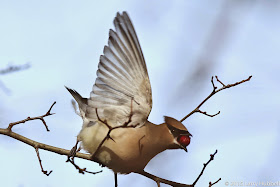For a couple of months, at least four sapsuckers have been working in the Arboretum. This particular sapsucker is unique in a number of ways. For one thing it is a red-naped sapsucker, while the other three are red-breasted sapsuckers. By the way, even though the term woodpecker is not included in their names, sapsuckers are part of the woodpecker family.
The red-breasted sapsuckers lack the black and white stripes on the head, but they are very similar in size and behavior to the red-naped. You can see more photos, about all the creatures who share the sap, in this earlier post.
Which reminds me, one day last week as I approached this tree at dawn, I was surprised to find two raccoons at the base of the tree. They appeared to be about a year old and they were each on opposite sides of the tree. I did not actually see them consuming the sap, but I suspect it attracted them.
The red-naped sapsuckers get their name from the small red spot on the back of the neck.
During the winter, red-naped sapsuckers are usually in Mexico or fairly close. Why this bird is here, this far north, is a mystery. Maybe it simply has a mind of its own or possibly it is hoping to mate with one of the red-breast sapsuckers or possibly global warming is making the northern states more attractive. In any case, what motivated this bird to winter in the Northwest is unknown to me.
However, what is keeping the bird in the Arboretum is not a mystery, it is clearly the sugary sap of its favorite tree. I have heard that the tree's common name is Spanish Fir, which of course is not a native northwest tree.
Last week, Dennis Paulson did a wonderful and inspiring post about sapsuckers and their sap wells. I learned that the larger, vertical excavations are from the sapsucker going for sap in the phloem cells, while the small round holes go deeper, through the cambium layer, to reach sap in the xylem cells. If I understand correctly, the xylem primarily brings water and minerals up from the roots, while the phloem redistributes sucrose, e.g. sugar, created via photosynthesis. The sucrose and the minerals are part of the inspiration for this week's title, Sugar and Spice.
Sugar and spice also refers to the fact that this bird is a female. Thank you to Ms. Jones who pointed out that the white patch directly below the beak is what identifies this bird as a female. In males the same area is red.
Each of the four sapsuckers, found in the Arboretum, have a particular tree that they consistently work. They have invested in their home trees by drilling and maintaining hundreds of sap wells. What is surprising is that the red-naped and the red-breasted sapsucker, shown above, have both apparently chosen the same tree as their "home".
The red-breasted sapsucker, who I think of as Eric the Red, appears to prefer a location about 4 or 5 feet from the ground, while the red-naped usually can be found working a site about 15 feet further up the tree. Eric appears to be a bit possessive while the female red-naped, let's call her Sugar, is far more flexible.
One morning last week, Eric fed at his spot for about an hour while Sugar consumed her breakfast overhead.
When Sugar hears Eric ascending the tree she vacates her spot. Immediately a hummingbird darts in to take advantage of the small window of opportunity.
Within a minute, Eric arrives and appears to proclaim, "The sap from this tree is all mine!"
However within 30 seconds Sugar simply returns and resumes her feeding.
Eric hears her working and a minute later he takes over Sugar's site, again.
Three minutes later, after Eric drops back down the tree, Sugar calmly returns to her sap wells.
In frustration Eric immediately charges up the tree again and…
…chases Sugar away. This time he takes to the air as he follows after her.
The Anna's hummingbird, ever alert for an opportunity, zooms in for a little more "carbo" loading.
Three minutes later Sugar returns having apparently ditched Eric in some distant portion of the Arboretum. Only instead of resuming her feeding at her normal location, Sugar decides to sample the sap from Eric's site.
Needless to say she keeps a close eye on the sky, watching for Eric's return, but she continues to feed in the process.
She consumes so much of Eric's sap that ten minutes later she has to make room for more or maybe she is just leaving him a reminder that she was there.
For the next hour she has all she wants. Which seems to prove that...sugar and spice and everything nice...wins in the end.
Have a great day on Union Bay…where nature lives in the city!
Larry
Note: By the way you can now find some of my photos on Instagram under the name, unionbaywatch.



















































